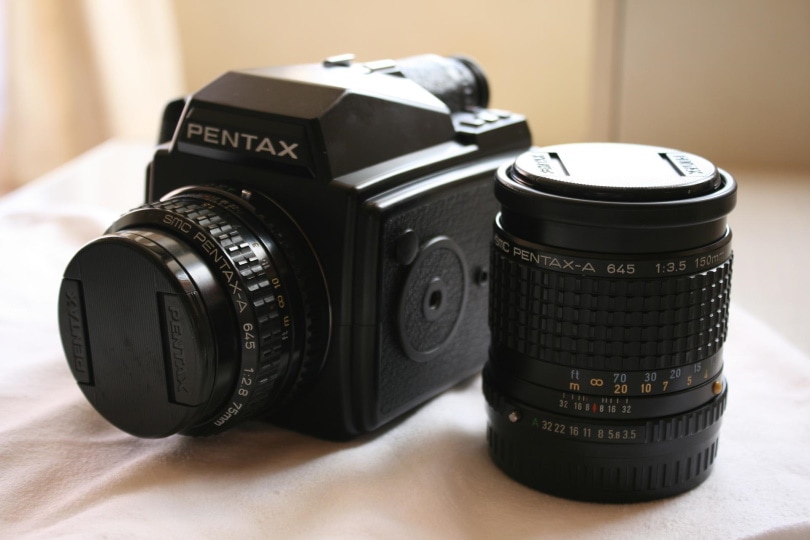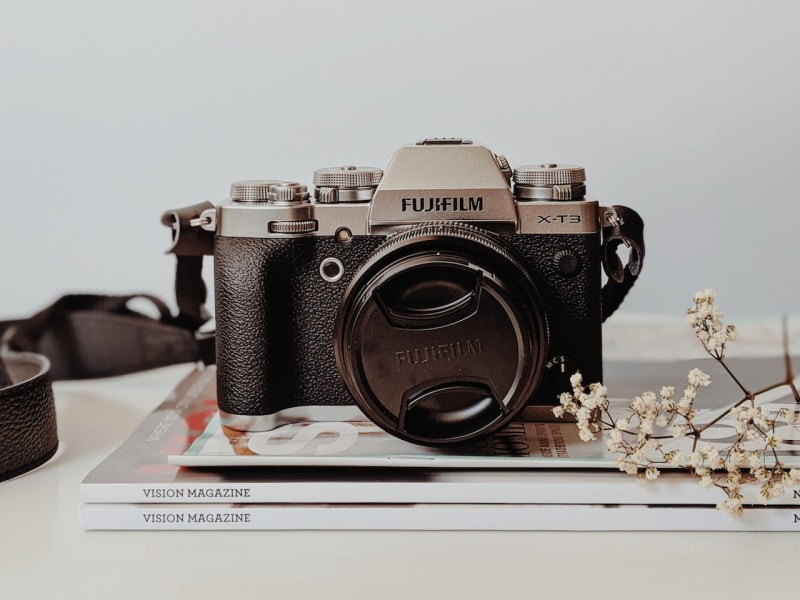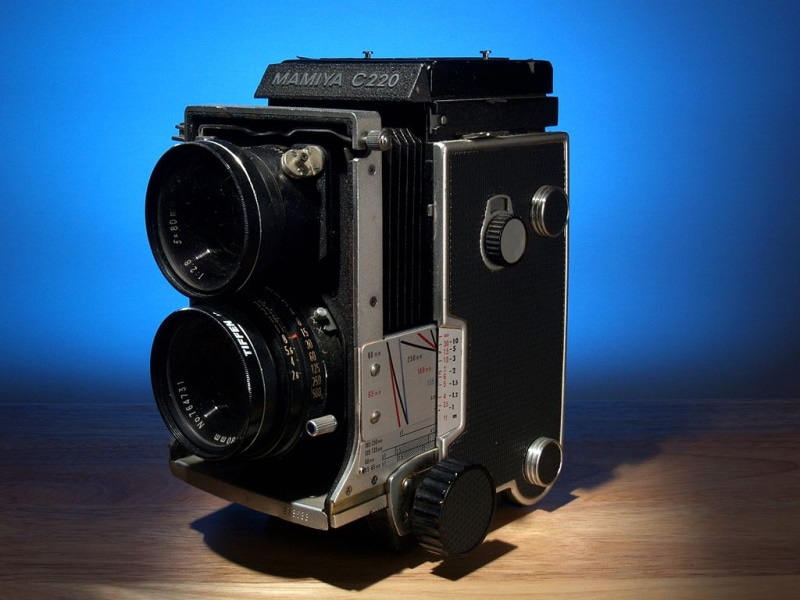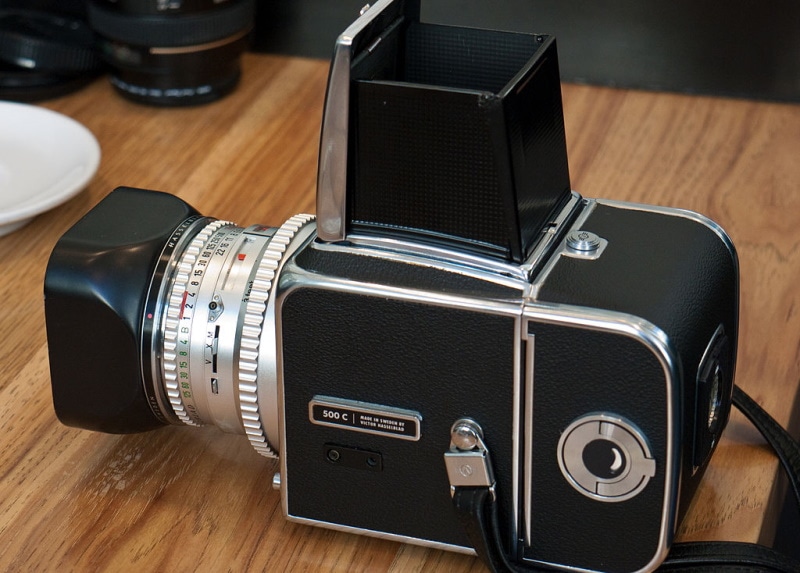What Are Medium Format Cameras & How Do They Work?
Last Updated on

Camera formats refer to the size of the sensor. While mobile phone cameras are the smallest format, the sensor size increases in large format cameras, such as the ones used in DSLRs. The sensor size is important because it affects the depth of field and the Low Light Performance of your camera.
A medium format camera has a larger sensor compared to a full-frame DSLR. It gives you much better image quality but makes the camera significantly bigger, more expensive, and harder to use.
Let’s discuss the use, advantages, and types of medium format cameras in detail to understand their place in photography.

How Does It Work?
Any camera format with a 120 film size or a digital imaging sensor that resembles this size is called a medium format camera. There’s no standard size for medium format. Rather, the sensor size differs from manufacturer to manufacturer. But as a rule of thumb, the sensor must be larger than 35mm (24x36mm).
Medium format cameras use a larger sensor to collect more light information. It results in better image quality, such as increased sharpness, accurate colors, and less noise. That’s why medium format cameras are widely used in advertising and fashion photography where capturing minute details is of utmost importance. Many of the magazine covers you see are shot with medium format cameras.
Famous fashion photographers, such as David Bailey and Terry O’Neill, used medium format cameras for taking fashion pictures even back in the 70s. Today, these cameras have advanced to include various features, such as autofocus and more.
Features of Medium Format Cameras

Several distinct characteristics set a medium format camera apart from smaller ones. Here are some of them:
Larger Size
The most obvious characteristic is that medium format cameras are physically larger, which allows for a bigger image sensor. Unfortunately, as a result, they’re also heavier and more expensive.
Luckily, many manufacturers are now releasing lighter and more compact models that are still capable of delivering high-quality images.
Larger Sensor
The sensor in a camera is what captures the image. It’s made up of millions of tiny light-sensitive cells, and the size of the sensor determines how many of these cells can be used.
The sensor size in digital medium format cameras can be up to 53.7mm x 40.2mm. A larger sensor means a high-res image, making the camera suitable for fashion or product photography.
Customizable
You can customize most medium format cameras according to your needs and preferences. For example, you can choose the type of viewfinder, focus system, and ISO range.
Multiple Aspect Ratios and Frame Sizes
Since you can change certain parts, such as the film back, you can shoot in multiple aspect ratios and frame sizes. The feature is excellent for photographers who want to experiment with different compositions.
For example, if you’re shooting in the 3:2 aspect ratio, you can change the film back to 4:3 or 6:4 and still use the same camera.
Better Low-Light Performance
Because of the large sensor size, medium format cameras perform better in low-light conditions. As a result, the images tend to be less grainy and have more detail.
That makes a medium format camera good for wedding or event photography where the lighting isn’t always ideal.

What Are the Types of Medium Format Cameras?

Medium format cameras are available in four main types, allowing photographers to select the best tool for the job.
Twin Lens Reflex
A Twin Lens Reflex (TLR) camera has two lenses of equal focal length mounted side by side. One lens is the primary lens that takes a photograph, while the other is used for composing the image and usually has a lower f-stop number.
The distance between these two lenses is usually the same as the distance between your eyes. It allows your brain to merge the two images into a single three-dimensional image. Unfortunately, these cameras have a fixed focal length in most cases, which means you can’t zoom in or out. But you can get telephoto, wide angle, and close-up adapters to attach to the front of the camera. They will give you more flexibility with your compositions.
TLR cameras were top-rated in the early to mid-twentieth century, but they fell out of favor when cheaper and more convenient 35mm SLR cameras became available. However, these cameras have made a comeback, especially among film photographers.
Rangefinder
A rangefinder medium format camera supports rangefinder focusing. It means that two separate rangefinder windows are placed on top of each other in the center of the viewfinder.
By aligning the images in the two windows, the rangefinder mechanism in the camera calculates the distance to the subject and sets the focus of the lens accordingly.
Typically, the lens size on a rangefinder is 180mm or 200mm. Moreover, these cameras have a limited range of focus.
SLR
An SLR (Single Lens Reflex) camera uses a mirror to reflect the image that passes through the lens. The photographer views this image directly through the viewfinder.
Upon pressing the shutter release, the camera’s mirror swings out of the way and allows light to hit the image sensor. The image is then recorded on film or a digital memory card.
SLR cameras are popular among professional and serious amateur photographers because they offer several advantages over other cameras. A medium format SLR camera is like any other regular SLR camera, except that it has a larger film size.
These cameras are ideal for telephoto and close-up photography due to the larger image size. However, they are more expensive and heavier than their 35mm counterparts.
Viewfinder
Medium format viewfinder cameras are generally classified by the film or digital sensor size. Most of these models are older, although Fuji recently released a modern foldable camera.
However, the foldable versions also have shortcomings, such as the lack of autofocus, electronic shutter, and sensor preview.
Viewfinder cameras using 120 films have been produced by many manufacturers, including Bronica, Mamiya, Hasselblad, and Pentax. In addition, some mini-view cameras also have a medium format roll film.
These cameras are ideal for cityscape or architecture photographers who require the extra image quality and detail that a larger sensor offers.
Where Is It Used?

Medium format cameras have many applications in professional photography. Here are some of them.
Landscape Photography
When shooting landscapes, a lot of detail is captured in the scene. It requires a large sensor to record all that information.
A medium format camera helps produce highly sharp and detailed images, making it the ideal choice for landscape photography. For instance, if you want to take a picture of a mountain range with all the intricate details, a medium format camera will be able to do that while a smaller sensor camera will not.
Wedding Photography
A medium format camera works well for wedding photography to take high-resolution pictures that can be blown up to large print sizes. Top-notch image quality is essential because wedding photos are often treasured for a lifetime and must be of the highest quality.
Another benefit of using medium format cameras in wedding photography is the cropping capability. Photographers can crop the pictures as per the album size without losing quality.
Editorial and Fashion Shoots
Think of a magazine cover or a billboard where a model is featured. The image must be extremely sharp and high resolution to look good even when printed large.
That’s why medium format cameras are commonly used in editorial and fashion shoots where the final print will be large. Photographers can print these images to cover anything from a billboard to a wall in an art gallery without compromising on detail.
Studio Portrait Photography
The color reproduction of medium format cameras makes them ideal for studio photography. In addition, medium format cameras don’t oversaturate the image, making the skin tone appear natural.
Plus, the large sensor size helps capture considerable detail, which is especially important when shooting portraits.
Advantages of Medium Format Cameras

Besides the fashion world, medium format cameras are also helpful in landscape and portrait photography. But the versatile application isn’t the only benefit of medium format cameras.
Wide Field of View
In photography, the field of view is the total area the lens can see. It’s determined by the focal length and size of the sensor. So, a lens with a wider field of view can “see” more.
With a wider field of view, you can capture more of the scene in front of you. For example, if you photograph a group of people, you can fit more people into the frame.
The field of view on a medium format camera is larger than 35mm cameras. That’s because the sensors in these cameras are larger.
Better Image Quality
Most people only associate high quality with DSLR and mirrorless cameras. But you get even larger megapixels with medium format cameras due to the large sensor size.
The sensor size allows you to take 70% larger pictures than full-frame cameras. However, you don’t lose image quality even at such a significant size. Higher megapixels also give you more leeway when editing your photos. For example, you can crop your picture without losing too much detail.
Shallow Depth of Field
The depth of field is the range of sharpness in your photo. The aperture, focal length, and distance from your subject determine the depth of field.
A shallow depth of field puts your subject in focus, but the background is blurred. Medium format cameras are perfect for wedding photography and portraits mainly due to this feature.
With a shallow depth of field, you can make your subject stand out against a busy background. The blurred background also adds a sense of depth to your photo.
Faster Shooting Speed
Medium format cameras have a faster shooting speed than most DSLRs and mirrorless cameras. That’s because they have a larger buffer size.
The buffer is the temporary storage space for your photos. A larger buffer means your camera can take more photos before it slows down.
A wedding or fashion photographer who needs to capture every movement will benefit from a fast shooting speed.
Versatile Shooting Range
Since medium format cameras typically have interchangeable parts, you can change the shooting range to fit your needs. For example, you can attach a wide-angle lens for landscape photography or a telephoto lens to take photos of distant subjects.
Some medium format cameras even come with built-in image stabilization. The feature is ideal for low-light and long-exposure photography.
Disadvantages of Medium Format Cameras

Although medium format cameras have several advantages, there are also some shortcomings that photographers should be aware of.
Size
The most notable shortcoming of medium format cameras is the size. These cameras are larger than traditional DSLRs and can be difficult to carry around. They also require a larger tripod, which can be cumbersome to transport.
Weight
If you’re covering a long event or wedding, be prepared to pack some extra weight. These cameras are usually much heavier than DSLRs, and the lenses are often quite large.
Cost
Medium format cameras are also more expensive than DSLRs. The cost of the camera body, lenses, and accessories can quickly add up.
Steep Learning Curve
If you’re new to photography, a medium format camera can be daunting. These cameras have more features and controls than a typical DSLR and can be overwhelming for beginners. Plus, working with the rangefinder can be tricky for those accustomed to using an optical viewfinder.
Limited Lens Selection
While most DSLRs have a wide selection of lenses, medium format cameras are often limited to only a few options. As a result, it can restrict photographers who want to experiment with different focal lengths and styles.

Frequently Asked Questions (FAQs)

Which Companies Make Medium Format Cameras?
Fujifilm, Hasselblad, Bronica, and Mamiya are a few manufacturers that make medium format cameras. If you’re interested in one of the older models, you can check the resale or used market to get your hands on an affordable medium format camera.
What Is the Difference Between a DSLR and a Medium Format Camera?
The main difference between these two types of cameras is the sensor size. A medium format camera has a much larger sensor than a DSLR, which allows you to capture more light and produce higher-quality images.
Is There a Medium Format Digital Camera?
Yes, manufacturers like Hasselblad, Fujifilm, and Leica make digital medium format cameras. These cameras are more expensive than DSLRs but offer better image quality and performance.
Why Are Medium Format Cameras Expensive?
The large sensor size of a medium format camera is more expensive to produce, making the cameras more expensive. In addition, the lenses needed to cover the larger sensor properly are also costly.
Do Professional Photographers Use Medium Format Cameras?
Yes, many professional photographers use medium format cameras because of the image quality they offer. These cameras are also popular among landscape photographers and those who shoot commercials or weddings.
Which Parts of Medium Format Cameras Are Interchangeable?
You can usually interchange the lenses, viewfinders, and film backs on most medium format cameras. Some manufacturers also make medium format digital cameras with interchangeable sensors.
When Should I Make the Switch to Medium Format?
If you’re a serious photographer who wants the best image quality possible, you may want to consider switching to a medium format camera. However, you should be prepared to spend a hefty amount on the camera, lenses, and other accessories.

Conclusion
Medium format cameras are ideal for fashion, portraiture, and landscape photography. That’s because their large sensors produce exceptional image quality.
But they are considerably more expensive than their full-frame counterparts. Plus, they pack extra weight and have a steep learning curve.
Featured Image Credit: kitakami_photo, Pixabay
Table of Contents
- How Does It Work?
- Features of Medium Format Cameras
- What Are the Types of Medium Format Cameras?
- Where Is It Used?
- Advantages of Medium Format Cameras
- Disadvantages of Medium Format Cameras
- Frequently Asked Questions (FAQs)
- Which Companies Make Medium Format Cameras?
- What Is the Difference Between a DSLR and a Medium Format Camera?
- Is There a Medium Format Digital Camera?
- Why Are Medium Format Cameras Expensive?
- Do Professional Photographers Use Medium Format Cameras?
- Which Parts of Medium Format Cameras Are Interchangeable?
- When Should I Make the Switch to Medium Format?
- Conclusion
About the Author Jeff Weishaupt
Jeff is a tech professional by day, writer, and amateur photographer by night. He's had the privilege of leading software teams for startups to the Fortune 100 over the past two decades. He currently works in the data privacy space. Jeff's amateur photography interests started in 2008 when he got his first DSLR camera, the Canon Rebel. Since then, he's taken tens of thousands of photos. His favorite handheld camera these days is his Google Pixel 6 XL. He loves taking photos of nature and his kids. In 2016, he bought his first drone, the Mavic Pro. Taking photos from the air is an amazing perspective, and he loves to take his drone while traveling.
Related Articles:
Binocular Magnification Chart: Numbers & Distances Compared
How to Clean a Refractor Telescope: Step-by-Step Guide
How to Clean a Telescope Eyepiece: Step-by-Step Guide
How to Clean a Rifle Scope: 8 Expert Tips
Monocular vs Telescope: Differences Explained (With Pictures)
What Is a Monocular Used For? 8 Common Functions
How to Clean a Telescope Mirror: 8 Expert Tips
Brightfield vs Phase Contrast Microscopy: The Differences Explained
